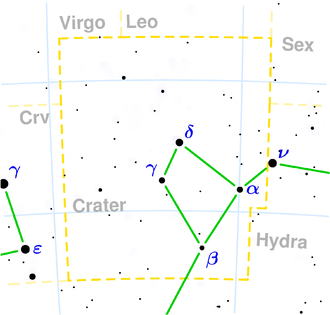NGC 3660
| Galaxie NGC 3660 | |
|---|---|
 | |
| SDSS-Aufnahme | |
| AladinLite | |
| Sternbild | Becher |
| Position Äquinoktium: J2000.0, Epoche: J2000.0 | |
| Rektaszension | 11h 23m 32,3s[1] |
| Deklination | -08° 39′ 31″[1] |
| Erscheinungsbild | |
| Morphologischer Typ | SB(r)bc;HII Sy2[1][2] |
| Helligkeit (visuell) | 12,2 mag[2] |
| Helligkeit (B-Band) | 13,0 mag[2] |
| Winkelausdehnung | 2,8′ × 2,3′[2] |
| Positionswinkel | 110°[2] |
| Flächenhelligkeit | 14,1 mag/arcmin²[2] |
| Physikalische Daten | |
| Rotverschiebung | 0.012285 ± 0.000007[1] |
| Radialgeschwindigkeit | (3683 ± 2) km/s[1] |
| Hubbledistanz vrad / H0 | (158 ± 11) · 106 Lj (48,4 ± 3,4) Mpc [1] |
| Geschichte | |
| Entdeckung | William Herschel |
| Entdeckungsdatum | 22. Februar 1787 |
| Katalogbezeichnungen | |
| NGC 3660 • UGC A 234 • PGC 34980 • CGCG 096-038 • MCG -01-29-016 • IRAS 11210-0823 • 2MASX J11233229-0839308 • Mrk 1291 • GC 2401 • H II 635 • | |
NGC 3660 ist eine Balken-Spiralgalaxie vom Hubble-Typ SBbc im Sternbild Becher. Sie ist schätzungsweise 158 Millionen Lichtjahre von der Milchstraße entfernt.
Das Objekt wurde am 22. Februar 1787 von Wilhelm Herschel entdeckt.[3]
Weblinks
Einzelnachweise
Auf dieser Seite verwendete Medien
Autor/Urheber: Sloan Digital Sky Survey, Lizenz: CC BY 4.0
The sky image is obtained by Sloan Digital Sky Survey, DR14 with SciServer.
Angle of view: 4' × 4' (0.3" per pixel), north is up.
Details on the image processing pipeline: https://www.sdss.org/dr14/imaging/jpg-images-on-skyserver/



